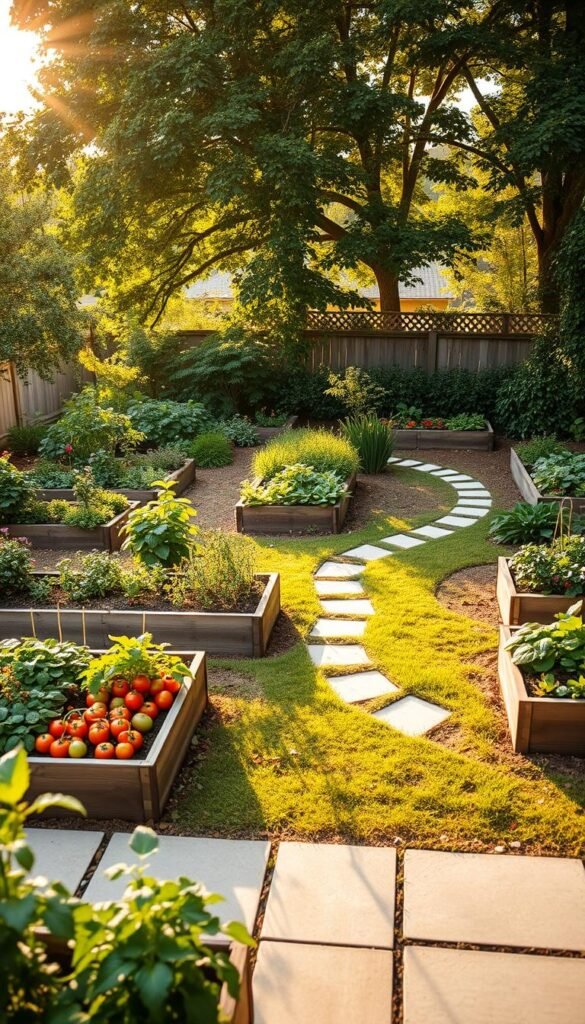Growing your own fresh food at home offers flavors and textures you won’t find in store-bought produce. Imagine biting into a sun-warmed tomato bursting with sweetness or crisp green beans that snap with every bite. This isn’t just about meals—it’s about building a deeper bond with nature while creating a sustainable source of nutrition.
You don’t need acres of land to succeed. Even a compact outdoor space can become a thriving source of leafy greens, herbs, and colorful veggies. The secret lies in smart planning and selecting plants that match your lifestyle and climate. Start with varieties you love to eat, and watch your confidence grow alongside your crops.
Many new growers worry about time commitment or lack of experience. Here’s the truth: success comes from simple steps, not perfection. Focus on sunlight patterns, easy-to-grow options, and efficient layouts. Compact varieties like ‘Bush Champion’ cucumbers thrive in small areas, while vertical trellises multiply your harvest potential.
This guide simplifies every step—from sketching your first layout to celebrating your inaugural harvest. You’ll learn how to avoid common pitfalls and create a low-maintenance space that fits your schedule. Let’s turn that empty corner into a vibrant, edible oasis that keeps your kitchen stocked all season.
Setting the Scene for Your Small Garden Adventure
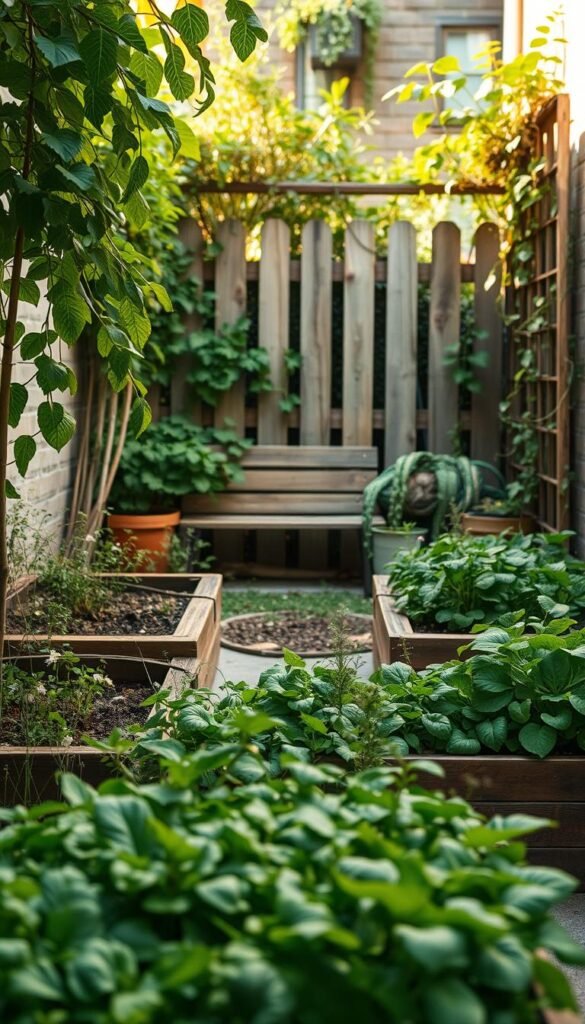
Your green thumb journey starts with smart observation. Walk through your outdoor area at different times to notice where shadows fall and sunlight lingers. Most edibles crave 6-8 hours of direct light daily, but shady spots aren’t wasted—they’re perfect for leafy friends like kale or spinach.
Identifying Your Available Space and Sunlight
Use a simple notebook to track light patterns over three days. Mark areas that get full sun versus partial shade. South-facing spaces often work best, but don’t stress if yours faces east or west. Container plants let you move sun-lovers like tomatoes as needed.
Check your soil’s drainage by digging a 12-inch hole. Fill it with water—if it drains completely in 2-3 hours, you’re golden. Rocky or clay-heavy spots? No problem. Raised beds bypass poor ground conditions while keeping weeds at bay.
Setting Realistic Garden Goals
Aim for a 10×10 foot plot—big enough for variety but manageable. Start with 3-5 favorite veggies and 2 herbs. Track your weekly availability: 15-minute daily checks beat marathon weekend sessions. Remember, even experienced growers face setbacks. One thriving tomato plant beats ten neglected ones.
Protect your garden from wind using tall crops like corn as natural barriers. Use vertical planters for cucumbers or beans if floor space is limited. Success comes from adapting, not perfection—each season teaches new tricks.
Planning Your Garden Layout for Maximum Efficiency
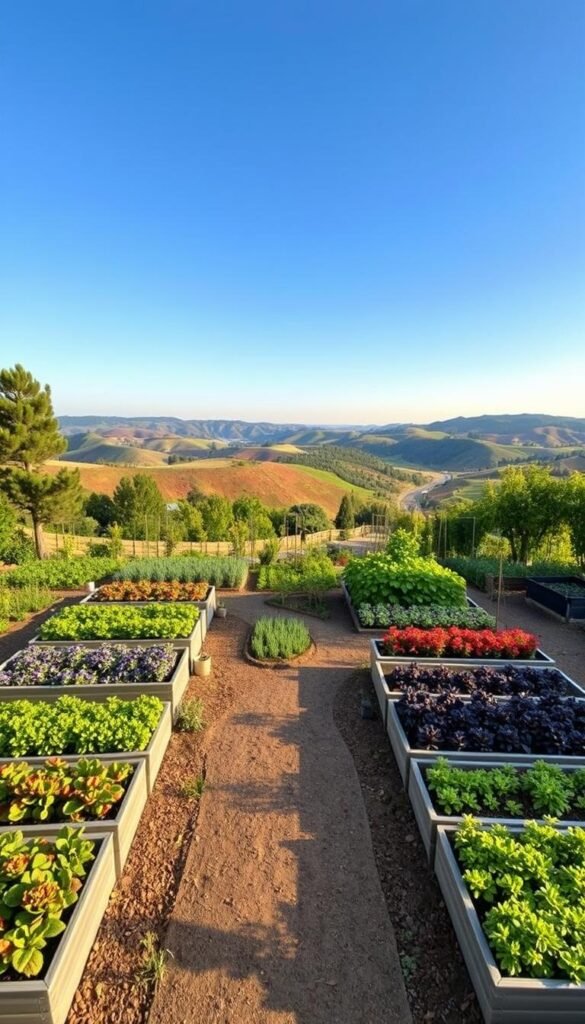
Transform every inch of your growing area into a powerhouse of fresh flavors. Smart organization turns limited space into abundant harvests through strategic plant placement and clever design.
Utilizing Blocks, Rows, and Vertical Spaces
Ditch single-file rows meant for tractors. Block planting groups vegetables in tight squares, letting leaves create living mulch that suppresses weeds. Try a perfect square foot gardening layout for precise spacing control.
Climbing plants like cucumbers reach for the sky when given trellis support. This vertical approach frees ground space for root crops or leafy greens. Pair tall structures with east-west plant orientation to prevent shade issues.
Integrating Pathways for Easy Access and Maintenance
Create 18-inch walkways using wood chips or gravel between beds. These narrow paths let you tend plants without compacting soil. Use dead-end routes in corner areas – like library stacks, they provide access without wasting prime growing real estate.
For raised beds, leave one side open for kneeling space. This simple trick makes watering and harvesting easier on your back. Remember: every step you save means more time enjoying your garden’s bounty.
From Patio to Produce: Backyard Vegetable Garden Design for Beginners
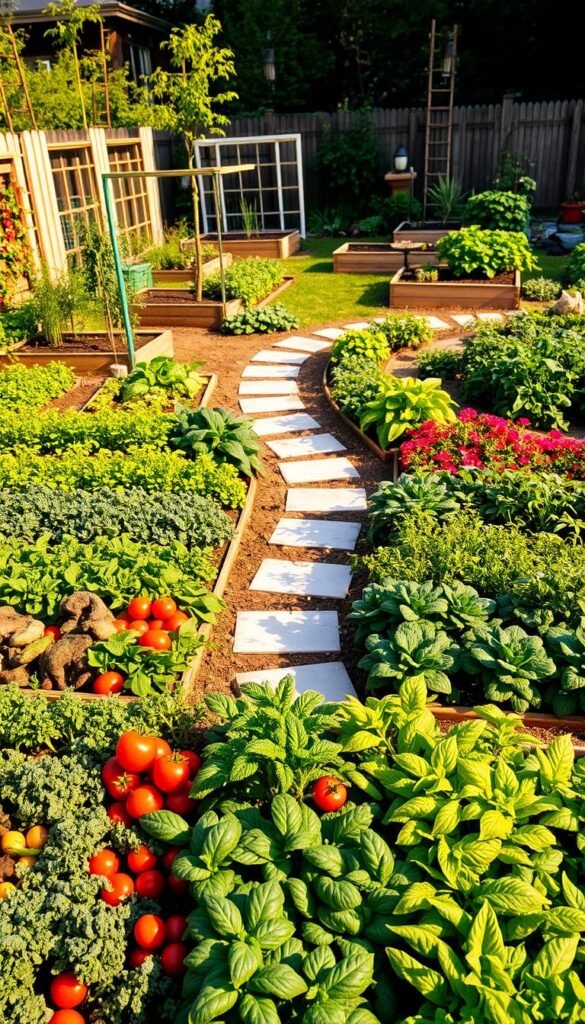
Your edible oasis begins with a vision that marries function and beauty. Before sketching layouts, ask yourself: “What do I want this space to become?” Some prioritize leafy greens for daily salads, while others dream of colorful blooms mixed with juicy tomatoes. There’s no wrong answer—only what makes your heart sing.
Defining Your Design Vision and Objectives
Jot down three core goals. Maybe you want to grow enough basil for weekly pesto, create a butterfly-friendly zone, or establish a meditative corner. These priorities shape your garden planning process. A food-focused plot might use tight plant spacing, while a relaxation-focused design could include winding paths and fragrant herbs.
Consider this comparison of popular approaches:
| Layout Style | Best For | Key Feature |
|---|---|---|
| Circular Mandala | Visual impact | Central focal point with radiating planting zones |
| Vertical Stack | Small spaces | Tiered planters with trailing squash or strawberries |
| Kitchen Companion | Quick harvests | Herbs and greens planted nearest the house |
Exploring Creative Layout Options
Break free from straight rows! Try a spiral herb garden using bricks as borders—it saves space and creates microclimates. Pair tall plants like pole beans on a decorative trellis with low-growing thyme for textural contrast. Even a 4×4 foot area can host four squash vines if you train them upward.
Remember to start small. Test one unconventional idea each season—maybe edible flowers bordering your lettuce patch. As you learn what works, your confidence (and harvests) will blossom alongside your unique design style.
Smart Planning: Selecting the Right Vegetables for Your Garden
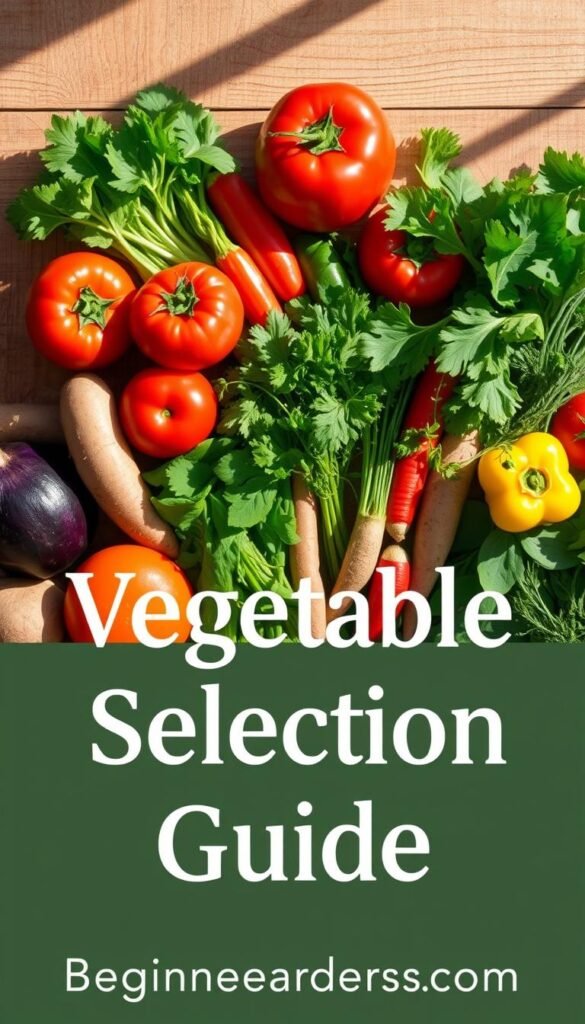
Your kitchen habits hold the key to a rewarding harvest. Grab your last grocery receipt—those frequently purchased items reveal what to prioritize. Focus on crops that replace store-bought staples while fitting your climate and available space.
Planting What You Love and Eat Regularly
Start with five veggies dominating your meal plans. Salad lovers might prioritize lettuce and cherry tomatoes, while stir-fry fans could focus on peppers and snap peas. Beginner-friendly options like bush beans and zucchini offer quick wins with minimal fuss.
Mix quick producers (radishes in 25 days) with long-season stars like tomatoes. This balance ensures continuous harvests from spring through fall. Cool-weather champs like kale thrive when temperatures dip, extending your growing season.
Understanding Companion Planting Strategies
Smart pairings boost yields and deter pests naturally. Try these proven combinations:
| Primary Crop | Companion | Benefit |
|---|---|---|
| Tomatoes | Basil | Improves flavor, repels flies |
| Cucumbers | Radishes | Marks rows, deters beetles |
| Carrots | Green onions | Confuses root pests |
For small-space success, explore vegetable garden layout ideas that incorporate these partnerships. Vertical growers like pole beans save ground space for heat-loving squash, while aromatic herbs protect vulnerable seedlings.
Starting Your Garden with Quality Seeds and Seedlings
The foundation of a thriving edible space begins with smart planting choices. Whether you opt for seeds or young plants, understanding their unique benefits helps maximize your limited ground area.
Why Seedlings Give You an Early Edge
Transplants skip the unpredictable germination phase, letting you fill gaps quickly. This approach saves weeks of growing time—crucial when working with compact spaces. Store-bought starters also reduce failure risks, ensuring every square inch produces food.
Mastering Seed Success in Tight Quarters
Choose fresh, high-quality organic seeds for faster sprouting. Soak pea or bean seeds overnight to speed up growth. Use shallow trays with drainage holes, and keep soil consistently moist—not soggy—until leaves emerge.
Label containers clearly and rotate them daily for even light exposure. Remember: start small with just 3-4 varieties to avoid overwhelm. As your confidence grows, so will your ability to nurture seeds into robust plants.

